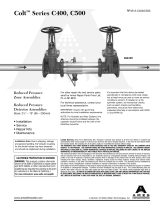
4
Removal and Service of the Relief Valve
1. Remove the relief valve cover bolts while holding the cover
down.
2. Lift the cover straight off. The stem and diaphragm assembly
will remain with the cover as it is removed. The relief valve
spring will be free inside the body at this point.
3. The relief valve seat is located at the bottom of the body
bore, and can be removed, if necessary, for cleaning. The
disc can be cleaned without disassembly of the relief valve.
If it is determined that the relief valve diaphragm and/or disc
should be replaced, the relief valve module can be readily
disassembled without the use of special tools. The disc rub-
ber is molded into the disc holder and is supplied as a disc
holder assembly.
4. To re-assemble the relief valve, press the seat firmly into
place in the body, center the spring on the seat, and insert
the cover and relief valve module as a unit straight into the
bore. Press down on the cover to assure proper alignment.
Insert and tighten bolts.
CAUTION
!
If cover will not press flat against body, stem assembly is crooked
and damage can result. Re-align stem and cover before bolts are
inserted.
Cover
Cover O-ring
Diaphragm
Stem & Diaphragm
Assembly
Retainer
Seat
Seat O-ring
Body
Flow
Relief Valve Ser-
vice Parts Kit
Test cock No. 3
Test cock No. 2
Test cock No. 4
Water Outlet
Relief valve Assembly
First Check
Module Assembly
Maintenance Instructions
After initial installation, a discharge from the relief valve opening may occur until all sealing surfaces have become seated or due
to inadequate initial flushing of pipe lines to eliminate dirt and pipe compounds. If flushing will not clear, remove the first check
valve and clean thoroughly.
Periodic relief valve discharge may occur on dead end service applications, such as boiler feed line or cooling tower makeup
lines, due to fluctuating supply pressure during a static or no flow condition. To avoid this discharge, install a check valve ahead
of the backflow assembly to “lock-in” the upstream pressure.
It is important that Series 4000B/LF4000B backflow preventers be inspected periodically for any discharge from the relief valve
which will provide a visual indication of need for cleaning or repair of check valves. Also, testing for proper operation of the
assembly should be made periodically in compliance with local codes, but at least once a year or more often, depending upon
system conditions. Most water purveyors require a test/inspection by a certified tester upon installation to verify the correct
operation of the assembly and that the installation complies with all code requirements.
Relief vent will discharge water when, during no-flow periods, (1) the first check valve is fouled or (2) the inlet pressure to
the device drops sufficiently due to upstream pressure fluctuations to affect the required operating differential between the
inlet pressure and reduced pressure zone. Otherwise, such relief (spitting) can occur when the second check is fouled during
emergency backflow or resulting from water hammer condition.
Second Check
Module Assembly








